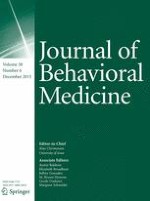04-09-2015
Body awareness and pain habituation: the role of orientation towards somatic signals
Gepubliceerd in: Journal of Behavioral Medicine | Uitgave 6/2015
Log in om toegang te krijgenAbstract
Although body awareness and pain perception are considered to be parts of the interoceptive system, the relationship between them is unclear. This study examines the association between body awareness and pain habituation, hypothesizing that this association is moderated by pain catastrophizing and mindfulness. Sixty subjects received a mildly aversive electrical stimulus for 60 s, during which they were requested to rate the amount of perceived pain. Complete habituation was indicated by abolition of pain sensation; partial habituation was indicated by a decrease in pain sensation. Individuals who demonstrated complete habituation had lower levels of pain catastrophizing and lower levels of mindfulness. As hypothesized, the association between body awareness and pain habituation was moderated by pain catastrophizing: Among low pain catastrophizers, the higher the body awareness, the stronger the tendency to exhibit complete habituation. Among high pain catastrophizers, the higher the body awareness, the greater the likelihood to present partial habituation.
